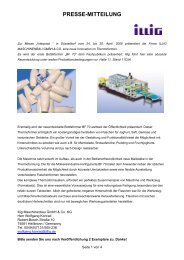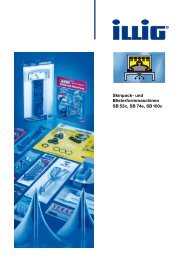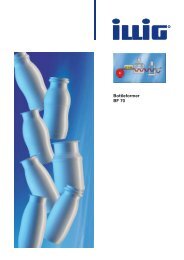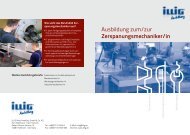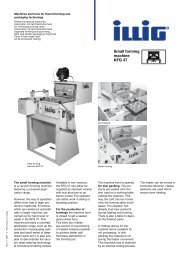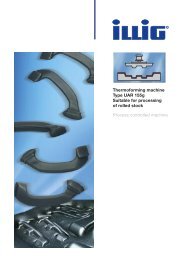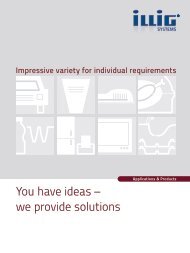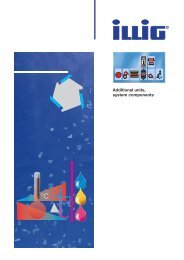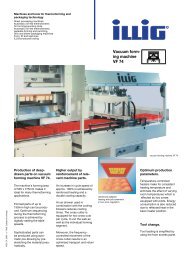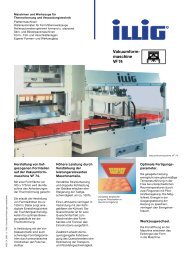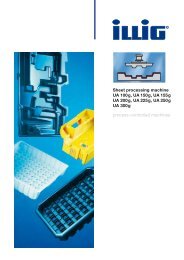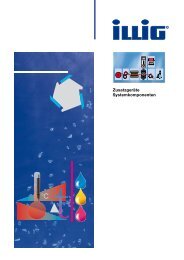Thermoforming - ILLIG Maschinenbau GmbH & Co. KG
Thermoforming - ILLIG Maschinenbau GmbH & Co. KG
Thermoforming - ILLIG Maschinenbau GmbH & Co. KG
You also want an ePaper? Increase the reach of your titles
YUMPU automatically turns print PDFs into web optimized ePapers that Google loves.
NEWS FROM MOLDMAKING<br />
The 3rd generation of RDM-K molds<br />
High dynamics and product uniformity at one stroke<br />
Synchronous pressure<br />
build-up – in all cavities<br />
Second-generation RDM-K molds reflect<br />
the state of the art of their time, with central<br />
valves handling the supply of forming<br />
air to all cavities. In the development of 3rd<br />
generation thermoformers, lateral valves –<br />
integrated into the mold – were used as a<br />
first step. Each of these valves controlled<br />
the supply of forming pressure to one<br />
single row of cavities. Although this method<br />
already constituted an improvement over<br />
the prior-generation, an absolutely synchronous<br />
airflow to the cavities could not<br />
yet be ensured in this manner. The task of<br />
forcing the material into conformance with<br />
the cavity contours and pressing it against<br />
the cooled mold wall (thereby initiating<br />
cooling) was completed within a given<br />
inter-cavity “time window”, resulting in<br />
non-uniform product characteristics.<br />
In the current 3rd generation molds,<br />
forming air is separately supplied to each<br />
cavity directly via the pre-stretcher (Fig. 1).<br />
<strong>Co</strong>mpressed air is thus gated directly into<br />
each cavity. To this end, a solenoid valve<br />
assigned to each cavity is fitted in the upper<br />
mold part for a defined, synchronous<br />
build-up of forming air pressure.<br />
The synchronous admission of forming<br />
air is all the more important in view of<br />
the severely reduced forming air input per<br />
cavity which is achieved through improved<br />
design (see p. 7). Even with this diminished<br />
air demand, a dynamic (steep) build-up<br />
and release of forming air pressure (Fig. 2)<br />
occurring simultaneously in all cup-forming<br />
cavities can thus be ensured.<br />
Advanced mold technology contributes<br />
in a major way to the high productivity<br />
and product quality attained by the 3rd<br />
generation RDM-K automatic pressure<br />
forming machines.<br />
Forming air<br />
Fig. 1: Each cavity now has its own solenoid<br />
valve for a controlled, precise and repeatable<br />
supply of forming air.<br />
Forming pressure [bar]<br />
3<br />
2<br />
1<br />
B<br />
0<br />
1 3 5 7 9 11 13 15 17 19 21<br />
Time [ms]<br />
A<br />
Solenoid valve<br />
Time gained<br />
Fig. 2: <strong>Co</strong>mpared to the prior standard<br />
(Case A), the reduction in forming air volume<br />
(Case B) results in a significantly more<br />
dynamic build-up and release of forming air<br />
pressure. The associated time gains can be<br />
used to run higher cycle rates.<br />
<strong>Co</strong>ntrolled pressure profile<br />
On 2nd generation molds, the full downholder<br />
force was commonly applied upon<br />
closing of the mold. This practice invariably<br />
resulted in the formation of a bead along<br />
the upper cup rim, as described in detail on<br />
page 7. However, in terms of process technology,<br />
the maximum downholder force is<br />
needed only during application of the full<br />
forming air pressure. During pre-stretching<br />
of the material and punching of the<br />
molded product the downholder force may<br />
be lower.<br />
With the new pressure level control<br />
system, the downholder contract pressure<br />
is adapted to the specific phase of the<br />
thermoforming process. The full downholder<br />
force is not exercised until the main<br />
forming air pressure sets in; it is then<br />
reduced toward the end of the molding<br />
cycle (Fig. 3). Another innovation is that<br />
that the downholders are cooled directly<br />
to support short cycle times.<br />
Optimized mold cooling<br />
The mold now comprises up to four cooling<br />
circuits. Individually controllable, these supply<br />
coolant separately to the upper mold<br />
part, the downholders, the lower mold part<br />
and the ejectors. In order to accelerate the<br />
dissipation of heat from the cavities, the<br />
molds have contour-following cooling<br />
passages of adequately sized crosssection.<br />
It is not necessary to reduce the coolant<br />
temperature – quite the opposite is true.<br />
While previously the coolant had to be<br />
at 12 °C, the new molds can be cooled with<br />
water in the 16 …18 °C range. This saves<br />
energy but also reduces the risk of moisture<br />
condensation in the mold, which is<br />
always extant at elevated air humidity<br />
levels.<br />
Pressure<br />
1 3<br />
Time<br />
1: Pre-cooling 2: <strong>Co</strong>oling 3: Punching<br />
Fig. 3: The clamping pressure of the cooled<br />
downholders is applied in stages matching<br />
the process to avoid bead formation along the<br />
upper cup rim. At the same time, the shorter<br />
application of the full pressure benefits mold<br />
and machine life.<br />
2<br />
thermoformer 1/2010 9



